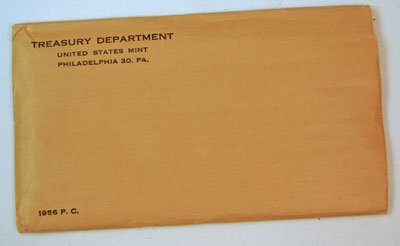In 1956, the US Mint’s proof sets were packaged in cellophane with individual compartments for each of the five coins – half dollar, quarter dollar, dime, nickel and penny. The cellophane was, in turn, sandwiched between two pieces of corrugated cardboard to protect the coins. The coins and the cardboard were then placed in a brown envelope, 3 1/2 inches by 6 inches much like the envelope in which a handwritten letter would be mailed in 1956.
In addition to the coin packaging, the US Mint included a small note to the purchasers of their proof coins:
This note says,
YOUR U. S. PROOF COINS
have been carefully inspected before release!
If there should appear – what may seem to you – a defect or a scratch on a coin, – it is no doubt a crease in the polyethylene-coated cellophane in which they are encased.
We tell you this to save us both unnecessary correspondence.
THANK YOU!
Rae V. Biester
Superintendent
With today’s frame of reference, that note could sound both boastful and arrogant. Plus, it would probably make people of today complain more not less.
But, remember this is 1956. Many of the people ordering the coin sets didn’t have a telephone. And, those who had access to telephones would not think to call the US Mint with any problems. A long distance call in 1956 cost roughly $12 per minute which in today’s dollars would be almost $100 per minute.
Furthermore, a customer would not pay $12 per minute to complain about a proof set for which they paid $2.10!
Plus, because people did not call with complaints in 1956, phone banks of customer services representatives did not exist to take customers’ calls. Instead, customer service reps received letters and responded accordingly to the letters.
A customer’s complaint – via letter – could take weeks to be satisfied. It also took US Mint’s people’s time and efforts to respond specifically to each person’s complaint.
Perhaps, too, since there was less automation in those days, they took greater care to make sure the proof sets were in pristene condition before leaving the Mint.
Could some of them been scratched or nicked before arriving at their destination? Perhaps, but probably not.
If this note explaining the creasing of the cellophane lessened the number of complaints, then the boastful and seemingly arrogant brevity would certainly have been worthwhile.
This small note is just a little piece of history that frequently gets lost as proof sets are bought and sold among dealers and collectors.

